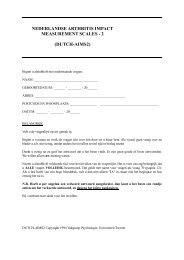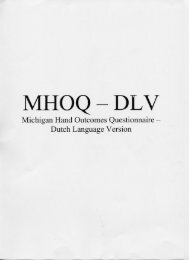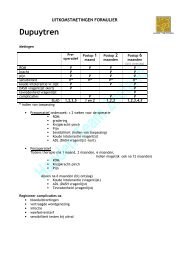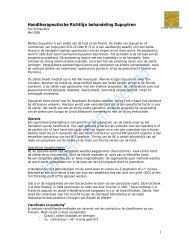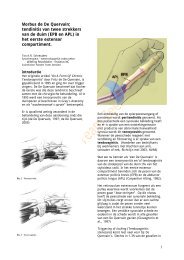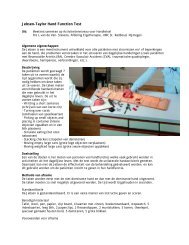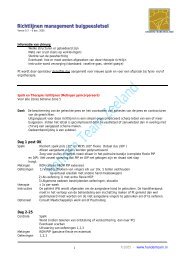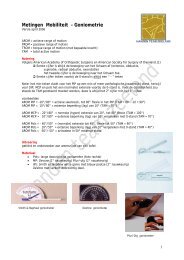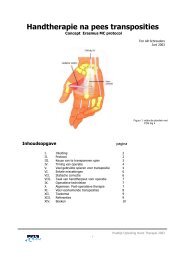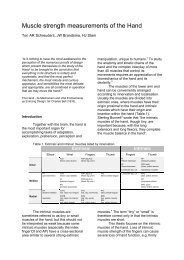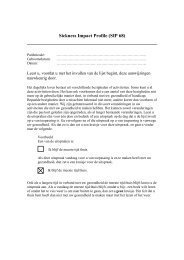414Table 1 Subjects’ demographicsTreatment groupPhysiotherapyNon-physiotherapyAge (years) (SD) 74.4 (10.2) 77.3 (5.1)Sex (M :F) 0:9 1:8Hand affected 5:4 4:5(dominant :non-dominant)Number of days 43.9 (4.4) 43.3 (5.1)immobilised (SD)Number of days until 44.2 (5.9) 41.4 (4.6)review (SD)Frykman classification 2 × I, 0 × II, 0 × III, 1 × IV, 1 × I, 1 × II, 2 × III, 1 × IV,(I–VIII) 1 × V, 0 × VI, 3 × VII, 2 × VIII 2 × V, 0 × VI, 0 × VII, 2 × VIIIData analysisA split plot analysis of variance (SPANOVA) was used <strong>to</strong> comparethe change in range of movement of active wrist extension, expressedin degrees, in the physiotherapy and non-physiotherapygroups. This comparison was made by evaluating the interaction(AB) effect.Data collected for grip strength in kilograms force failed <strong>to</strong> meetthe assumption of homogeneity of variance, and therefore the samedata analysis could not be used. A Mann-Whitney U-test was employed<strong>to</strong> compare the change scores (final strength minus initialstrength) for the two groups. The Mann-Whitney U-test is the nonparametricequivalent <strong>to</strong> a t-test carried out on the change scores,which is mathematically equivalent <strong>to</strong> the AB interaction effect determinedusing a SPANOVA [12].One-tailed tests were used for both the analysis of change instrength and change in range of wrist extension. The level of significancewas set at P = 0.05.ResultsWrist extensionThe increase in wrist extension between the initial measurementand the 6-week follow-up was significantly greaterin the physiotherapy group (Fig.1).Fig. 2 Initial and final mean grip strength for the physiotherapyand non-physiotherapy groups. The median (interquartile range) isdenoted at the bot<strong>to</strong>m of the figure. Small circles represent outlierswhich failed <strong>to</strong> fall within the 10th and 90th percentiles, denotedby error bars. The extremities of the boxes represent the 25th and75th percentiles, sometimes referred <strong>to</strong> as the interquartile range,and the solid line inside the box represents the medianGrip strengthThe increase in grip strength between the initial measurementand the 6-week follow-up was significantly greaterin the physiotherapy group (Fig.2).DiscussionFig. 1 Initial and final mean wrist extension for the physiotherapyand non-physiotherapy groups. Standard deviation denoted by errorbars. Mean and standard deviation for each group denoted atthe bot<strong>to</strong>m of the figureOur results suggest that <strong>routine</strong> <strong>referral</strong> of Colles’ <strong>fracture</strong><strong>patients</strong> <strong>to</strong> physiotherapy following cast removal is beneficial.The greater increase in wrist extension and gripstrength in those <strong>patients</strong> receiving physiotherapy was clinicallysignificant given that the <strong>fracture</strong>s were at the stageof consolidation of <strong>fracture</strong> healing [1]. At this stage <strong>patients</strong>may recommence all hobbies and return <strong>to</strong> heaviermanual work. Subjects who did not attend physiotherapywould have found many of these tasks difficult due <strong>to</strong> lackof the necessary wrist extension and grip strength requiredfor optimal prehension. However, subjects who attendedphysiotherapy possessed the necessary wrist extension andgrip strength, making the transition <strong>to</strong> such activitiesmuch easier.
Although not the primary aim of the study, we hypothesisethat the physiotherapy group did better than the nonphysiotherapygroup because they <strong>benefit</strong>ed <strong>from</strong> reinforcemen<strong>to</strong>f both home advice and active exercise. Suchreinforcement included clinical reasoning on the part ofthe treating therapist which incorporates decision-making,problem-solving and making clinical judgements [5]. Aprevious study failed <strong>to</strong> find any <strong>benefit</strong> <strong>from</strong> the additionof passive joint mobilisation <strong>to</strong> physiotherapy for Colles’<strong>fracture</strong> <strong>patients</strong> following cast removal [13]. There is aneed for further investigation <strong>to</strong> determine the importantcomponents of physiotherapy in Colles’ <strong>fracture</strong> rehabilitation.Past studies that have compared physiotherapy <strong>to</strong> nophysiotherapy in Colles’ <strong>fracture</strong> <strong>patients</strong> have shown nodifference in outcome [9, 10]. Pasila et al. [10] analysed96 <strong>patients</strong> <strong>to</strong> determine whether recovery was hastenedwhen exercise was supervised by a physiotherapist. No statisticaldifference could be detected. However, this wasexercise of the non-involved joints during the period ofimmobilisation. Hence, these exercises could not have beenexpected <strong>to</strong> influence the range of movement around thewrist following cast removal.Oskarsson et al. [9] compared supervision by physiotherapists,starting 4–6 weeks after cast removal, with selftrainingin 110 Colles’ <strong>fracture</strong> <strong>patients</strong>. Despite their conclusionthat physiotherapy subjects had the same outcomeas non-physiotherapy subjects, inspection of their raw datatable demonstrated that subjects in the physiotherapy groupshowed a greater increase (P = 0.01) in wrist movementthan subjects in the non-physiotherapy group. Such a findingis consistent with our study.In conclusion, we found that Colles’ <strong>fracture</strong> <strong>patients</strong> referred<strong>to</strong> physiotherapy demonstrated a greater increase inwrist extension and grip strength in the period <strong>from</strong> <strong>fracture</strong>union <strong>to</strong> consolidation than <strong>patients</strong> who received noactive therapy.References4151. Adams JC, Hamblen DL (1992) Outline of <strong>fracture</strong>s, 10th edn.Churchill Livings<strong>to</strong>ne, Edinburgh, pp 41–422. American Society of Hand Therapists (1992) Clinical recommendations,2nd edn. ASHT, Chicago3. Apley GA, Soloman L (1993) Apley’s system of orthopaedicsand <strong>fracture</strong>s, 7th edn. Butterworth Heinemann, Oxford, p 1504. Frykman G (1967) Fracture of the distal radius including sequelae-shoulder-hand-fingerssyndrome, disturbance in the distalradio-ulnar joint and impairment of nerve function. Acta OrthopScand Suppl 1085. Gass EM, Refshauge K (1996) Theoretical basis underlying clinicaldecisions. In: Refshauge K, Gass EM (eds) Musculoskeletalphysiotherapy: clinical science and practice. Butterworth-Heinemann, Oxford, ch 26. Kapandji IA (1970) The physiology of the joints, Vol 1. ChurchillLivings<strong>to</strong>ne, Edinburgh, p 1447. LaStayo PC, Wheeler DL (1994) Reliability of passive wristflexion and extension goniometric measurement: a multicentrestudy. Phys Ther 74 :162–1768. Mathiowitz V, Weber K, Volland G, Kashman N (1984) Reliabilityand validity of hand strength evaluations. J Hand Surg[Am] 9 :222–2269. Oskarsson GV, Hjall A, Aaser P (1997) Physiotherapy: an overestimatedfac<strong>to</strong>r in after-treatment of <strong>fracture</strong>s in the distal radius?Arch Orthop Trauma Surg 116 :373–37510. Pasila M, Karahapju EO, Lepis<strong>to</strong> PV (1974) Role of physicaltherapy in recovery of function after Colles’ <strong>fracture</strong>. Arch PhysMed Rehabil 55 :130–13411. Roumen RMH, Hesp WLEM, Bruggink EDM (1991) UnstableColles’ <strong>fracture</strong>s in elderly <strong>patients</strong>. J Bone Joint Surg [Br] 73 :307–31112. Streiner DL, Norman GR (1995) Health measurement scales: apractical guide <strong>to</strong> their development and use, 2nd edn. Mosby,St Louis, pp 169–17013. Taylor NF, Bennell KL (1994) The effectiveness of passivejoint mobilisation on the return of active wrist extension followingColles’ <strong>fracture</strong>: a clinical trial. NZ J Physiother 22 :24–28



